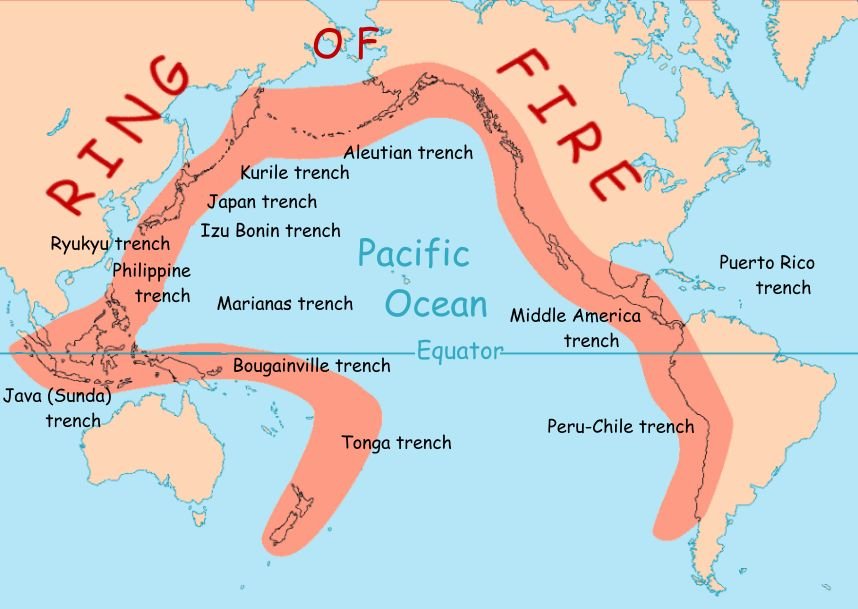Unveiling the Secrets of the Ring of Fire Volcanic Chain
Image courtesy of National Geographic
Nature has a way of reminding us of its astonishing power and unpredictability. One of its most awe-inspiring displays is the Ring of Fire, a horseshoe-shaped belt of seismic and volcanic activity that encircles the Pacific Ocean. This fascinating phenomenon, characterized by its volcanic eruptions, earthquakes, and tectonic movements, offers a glimpse into the intricate dynamics of our planet's geology. In this blog post, we'll embark on a journey to unravel the mysteries of the Ring of Fire volcanic chain and better understand its significance.
The Ring of Fire: A Geological Marvel
Stretching over 25,000 miles (40,000 kilometers), the Ring of Fire is a colossal arc that connects several tectonic plate boundaries. This intricate network of subduction zones, divergent boundaries, and transform faults is responsible for creating some of the world's most iconic and active volcanoes. From the towering peaks of the Andes in South America to the Pacific Northwest's volcanic ranges, this chain leaves an indelible mark on the landscapes it traverses.
Subduction Zones: The Catalysts of Catastrophe
One of the primary contributors to the Ring of Fire's intense volcanic activity is the presence of subduction zones. These zones occur where one tectonic plate is forced beneath another into the Earth's mantle. As the subducting plate descends into the hot interior, it releases water and other volatile substances, which then trigger the melting of surrounding rock. This molten material rises to the surface, resulting in explosive volcanic eruptions. Notable examples of subduction zone volcanoes include Mount St. Helens in the United States and Mount Fuji in Japan. Subduction zones are also home to the most catastrophic and powerful earthquakes and tsunami’s in the world. The 2004 Thailand tsunami and the 2011 Japan tsunami were both brought on by subduction zones. Oregon has its own looming subduction zone tsunami that we will dive deeper into in a future blog post. .
The Ring of Fire's Role in Earth's Evolution
Beyond its immediate dangers, the Ring of Fire plays a crucial role in shaping Earth's surface and evolution. Volcanic activity contributes to the recycling of elements between the Earth's interior and its surface. Minerals released during eruptions enrich the soil, supporting lush vegetation and diverse ecosystems. Additionally, volcanic islands that emerge from the ocean floor become habitats for unique species, contributing to biodiversity and scientific discovery.
A Hub of Scientific Exploration
The Ring of Fire's dynamic nature has captured the attention of scientists and researchers worldwide. Monitoring and studying the region's seismic activity, volcanic eruptions, and geothermal features offer valuable insights into plate tectonics, magma formation, and Earth's inner workings. By analyzing data from these areas, scientists can better understand the mechanisms behind volcanic eruptions and potentially develop improved prediction models.
The Ring of Fire’s Impact on Central Oregon
With a string of volcanoes such as Mt. Hood, the Three Sisters, Mt. Bachelor, and Crater Lake dotting the state north to south, Oregon is the 2nd most volcanic state in the country topped only by Hawaii. Both Oregon and Hawaii have the Ring of Fire volcanic chain to thank for their volcanic prowess. In the pacific northwest, the Juan de Fuca Plate is being pushed under the North America Plate in an area off the coast known as the Cascadia Subduction Zone. As the Juan de Fuca is pushed deeper into the Earth, it triggers that release of gasses and molten energy that slowly gives way to volcanoes, hot springs, and other geothermal phenomenon. It is because of the Ring of Fire chain that we have these stunning volcanoes, lava tube caves, and hot springs. Our local landscape has been shaped by volcanic activity with lava flows redirecting our rivers, turning valleys into lakes, and so much more!
The Ring of Fire volcanic chain is a testament to the Earth's active and dynamic nature. From awe-inspiring eruptions that shape landscapes to the risks they pose to nearby populations, this horseshoe-shaped belt serves as a stark, yet incredible reminder of nature's power and complexity. As we continue to unravel the mysteries of the Ring of Fire, we gain a deeper understanding of our planet's geological history and the intricate processes that have shaped and continue to shape our world.


